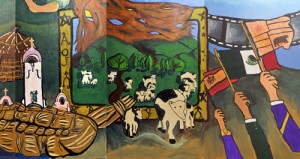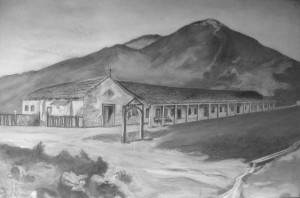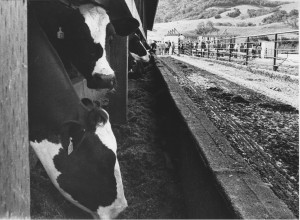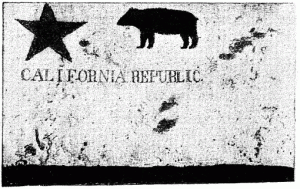Matthew Jackett is a junior at Marin Academy, interested in history and writing. As a 2012 summer intern for the Marin History Museum, Matthew wrote a series of blog posts on the mural by Davidson Middle School students recently installed on Youth in Arts refurbished facade at 917 C Street. This is the second post in that series.
In the mural, the Mission San Rafael Arcángel is depicted encroaching on the section of the mural dedicated to the Miwoks, representing the way that the Spanish missionaries encroached on the Native American people. It was a significant turning point in the history of Marin, with the first of many foreign presences taking power. The Mission San Rafael was constructed in 1817 as an extension of the Mission San Francisco. It functioned as a sanitarium for sick Native Americans due to the better weather outside of San Francisco. It developed from a sub-mission of San Francisco into an independent mission in 1822 as the ranch and farm built around the mission began developing. The Native American people living in the area maintained all of the orchards, herds of livestock, and buildings. An estimated 1,500 to 2,000 Native Americans lived in Marin at the time, although the number sharply decreased to as few as 250, as a result of the colonial presence.
In 1834, San Rafael became the first mission to secularize, and in 1846 it was taken by General John C. Fremont as a headquarters during the Bear Flag Revolt. The mission then deteriorated until it was restored and reconstructed in 1949.
Next to the mission in the mural is a herd of cattle. The California Gold Rush spurred the start of the dairy farming industry of Marin. Men who came seeking gold and riches were often disappointed with a lack of success and the rough life in the dangerous camps, and upon returning to San Francisco, some would set up farms and ranches up north in Marin. The lush grass that grew in the hills of Marin was some of the best in California, and the new farmers took advantage of that to feed cows meant to produce high quality butter and cheese. They were then able to use the population boom of 49ers to create a market in which they could sell their products.
The cattle in the mural are surrounded by a frame that is decorated with cattle brands that local farmers used in the 1840s through the 1860s. Mentor Artist Brooke Toczylowski saw the brands in a book at the Marin History Museum and showed them to the Davidson student artists, who later decided to include them in the mural. The brands were unique for each farmer, put on the cattle to identify ownership. The book of branding symbols at the Museum starts in Spanish and ended in English. Similarly, in the mural, the brands gradually change from ones belonging to Spanish farmers during the time of the Mission to American farmers after the Gold Rush. This represents the change in regime in California over those years.
The flags at the end of this section of the mural are the flags of Spain, then Mexico, and then the Bear Flag of 1846, developed by California Anglo-Americans wanting independence from Mexico. The Bear Flag has been adapted into the California State flag of today.
This section of the mural shows the transition from the Native American Miwok way of life, through the Mission San Rafael and Spain, into the Mexican period and the beginning of Marin being a part of the United States. This was followed by the growth in population and industry that came with the Gold Rush, making the Bay Area what it is today.
Read “History Behind the Mural, Part 1”
Read “History Behind the Mural, Part 3”
The San Rafael history mural at Youth in Arts was created with support from the County of Marin, the Fenwick Foundation, the MacPhail Family and the Marin Community Foundation. Youth in Arts will host a public reception and celebration of the mural on Friday, September 14, from 5-8 p.m. The event will include a dedication ceremony at 6 p.m. and the opening of a new exhibit on the creation of the mural by Davidson students.




